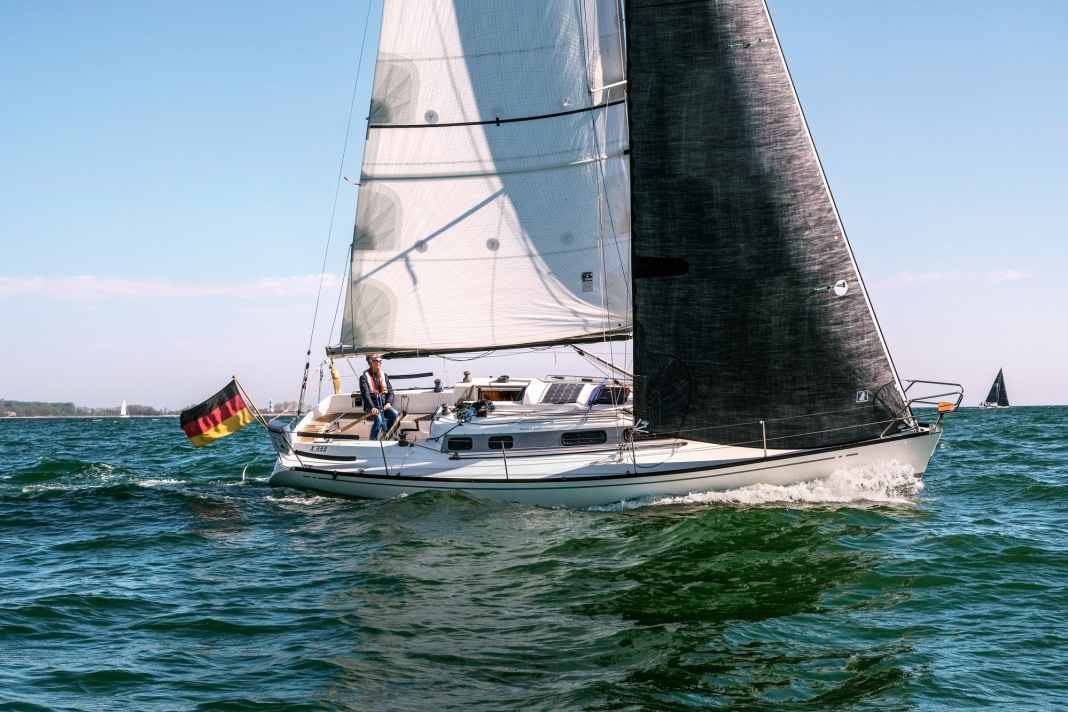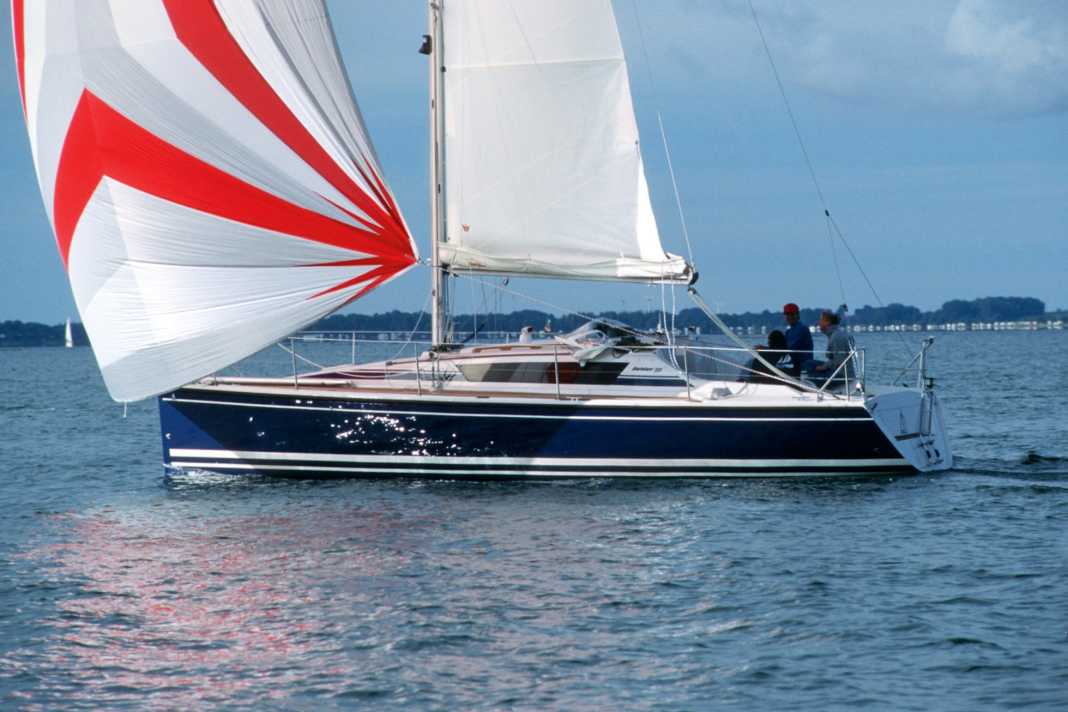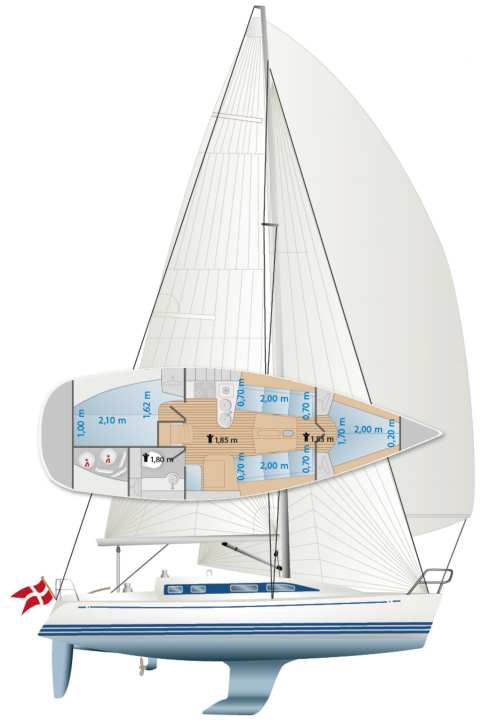





- In sporting terms, only a few can play at eye level, but in terms of price there are often cheaper options
- The measured values for the used boat test of the X-322
- The X-332 in detail
- Model history and design
- Market situation
- You should pay attention to this
- Equipment and prices
- YACHT rating of the X-332
The X-332 "Flux" from Norway, built in 2000, took victory in the large C class (28 entries) in the ORC double-handed world championship off Oslo. The boat was not only sailed cleanly, it also measured up fairly and performed well with a race score of 553.8. The success is proof that the ORC formula works, which also gives older boats a chance of winning, and also of the quality of the X-332.
And if a certified yacht valuer buys a particular boat, then that's a good sign for that model. This was the theory when YACHT used boat expert Uwe Gräfer sold his beloved Grinde and switched to an X-332, much to the dismay of his fanbase. Rumour had it in the community that he had become soft on requests for a proper "bathroom", berths with doors to separate someone's snoring from the rest of the crew, a more comfortable galley possibly with an oven and similar junk for the spoilt.
And one thing was immediately clear to everyone on the scene: anyone encountering Gräfer's "Holly" anywhere on the Kiel Fjord or in Denmark need not imagine that they can follow him, as is sometimes the case with somewhat larger boats with the Grinde.
Perhaps that's why Gräfer can't hide a certain pride of ownership at the test date in Schilksee. "The boat simply sails superbly and is still fully seaworthy. There are only a few competitors in this size and for this age," he summarises. There will be more to say about this later.
In sporting terms, only a few can play at eye level, but in terms of price there are often cheaper options





But first of all, it should be noted that the X-332, which the shipyard in Haderslev built from 1995 to 2005, was an absolute bestseller for the Danes. A total of 432 units were built, with only the evergreens X-79 and X-99, which had established the shipyard's reputation in previous years, being sold even more frequently.
At that time, the shipyard already had a reputation: the boats were fast, often found at the front in regattas, innovative and solidly built. But they also had high rigs with backstays that you had to be able to handle, and for upwind courses it was best to have a couple of guys on the edge who were as heavy as possible, otherwise the boat would lie on its side or you would have to reef very early.
Designer Niels Jeppesen considers the X-332 to be one of the best designs of his career
The X-332 was supposed to be completely different. How exactly? A call to its designer and X-Yachts founding member Niels Jeppesen, who now runs the yacht design office Jep-pesen-Pons and designs for Arcona, among others.
"Together with the 302, which was developed at the same time, the 332 was one of the first designs that we developed completely free of the formula constraints of the IOR era in 1994. This resulted in clean hulls that were much more stable." This was well received and the boat sold well right from the start. "She is probably one of my 'best babies', I would say. I sailed her myself privately at regattas and with my family for four years and won the Rundt. She should simply be a good all-rounder."
That's why she was fitted with a lead keel bomb, so that she sails comfortably, but also fast and high upwind. Rod rig and steel frame in the floor assembly so that the energy from the sails is not dissipated somewhere in the ship. Sandwich hull with foam core, tanks and batteries low and in the centre of gravity, folding propeller. "Simply the differences that separate a good boat from an average ship," says Jeppesen. Although the 302 and 332 were practically sister ships, the larger one sold significantly better. "I suspect it was because the 332 fitted slightly better into the short Baltic wave," says Niels Jeppesen.
The sailing performance is excellent and the boat is still used for regattas
Her 9/10 rig with two spreaders by John Mast does not need backstays because of the swept spreaders, which certainly made the decision easier for many buyers. It is fair to say that the 332 was one of the co-founders of the term cruiser/racer, which began to make the rounds in the nineties.
Even the brochure made it clear at the time that regatta sailors were also the target group - race crews can be seen in action in almost all of the sail pictures. Nevertheless, the boat's credo was: "The racing sailor will immediately feel at home at the tiller, and the cruising sailor can discover a whole new world of sailing pleasure." That was the theory.
On the Kiel Fjord, the wind was blowing very gusty from the east on the test day, with the anemometer constantly jumping between 13 and just over 20 knots. When we go on board, we immediately notice the high-quality equipment: very far inboard, line-adjustable genoa tracks, even with an extra barber furler, were already standard. Below-deck furling system for the forestay, wide mainsheet traveller, powerful 16:1 reduction backstay tensioner. The Gräfer boat is now almost 20 years old, all parts are still original, work and are correctly dimensioned, as the owner assures us. Only the mainsheet has had one more gear ratio shorn, including fine adjustment - after all, you're not the youngest anymore.
The boat is noticeably sensitive on the rudder
The cockpit is easily accessible thanks to the tiller (a wheel was only available as an option), and the recessed traveller does not detract from comfort in the harbour or at anchor when the crew are lounging on the thwarts. A small but adequate bathing platform for getting in and out of the water is a perfect match.
As there are supposed to be thunderstorms later, we quickly head out onto the fjord. A brand-new laminate mainsail (Tape-Drive-Silver) and a Genoa 3 with Flex-Sport cloth go up. You don't treat yourself to anything else. The X-332 is rarely seen with cheap Dacron cloth. And in fact, she is still popular today and is sailed relatively far ahead in regattas on the Baltic Sea. The yardstick (93) is low, but fits. According to ORC, the boat measures favourably. In many regattas such as Silverrudder, Vegvisir and the like, the boats regularly appear at the front of the results lists. So if you want to, you can.
All lines are redirected into the cockpit and fitted with a clamp battery around the companionway. Trimming, reefing, everything done quickly. The 332 sets off well in a gusty wind of around 4 Beaufort. Upwind at almost 6.7 knots, opening the sheets a little and dropping down, the hull speed is almost immediate, amounting to 7.2 knots. Halfway upwind, the log is already tugging at 7.5 knots, which is marvellous. The boat is already noticeably sensitive on the rudder, which owner Gräfer has replaced. "The boat sometimes had a little too much rudder pressure when there was a lot of leeway or under spinnaker, and as the blade was no longer that good anyway, I had a new one built that reaches a little deeper and has a little more profile."
Ergonomics and layout, operation, everything fits
As the wind becomes increasingly gusty and dark clouds remind us of the storm, we quickly hoist the spinnaker. With the waves coming diagonally from astern, the X now pushes off powerfully, quickly reaching 8.5 knots on the log. The boat remains perfectly under control at all times. And that with a two-man crew. Then the gusts pass the 20-knot mark, we run out of leeway and recover the sails.
In fact, the boat conveys pure, immediate sailing pleasure. Ergonomics and layout, handling, everything fits, a boat that really makes you feel at home. The seating position at the tiller, the fairly deep cockpit, the riding position - everything is perfect. The electronic equipment rack above the hatch has space for four displays and is ideal for keeping an overview, and the running decks are nice and clear thanks to the genoa travellers positioned far inboard. You get an idea of why the boat sold so well.
Gradually, you involuntarily start to look for the fly in the ointment. Surely there must be a few flaws? In any case, the rudder is not a specific problem, as Gräfer knows as an expert: "In general, the connection between the rudder stock and the blade is a point where water can get into the laminate over the decades. You should always take a close look there; a simple moisture measurement will quickly clarify the situation." Speaking of osmosis? Not a known problem with the 332, according to the expert.
A look under the floorboards confirms: no hairline cracks, no rust
He can only think of small things: The GRP around the tiller fitting can break out a little at the corners when the tiller is folded and moved. Many owners have already shortened the corners there. Similarly, if the owner is sailing with too little forestay tension and the stay rubs against the deck in the passage to the lower furling system. This can leave marks or put more strain on the laminated stainless steel in the bow. So it doesn't hurt to take a look.
The floor assembly of the X-332 is considered to be exceptionally robust due to the laminated, galvanised steel frame, which can probably only be damaged by rough ground contact. A look under the floorboards confirms this - no hairline cracks, no rust. This also applies to the sports version, which was only offered after the turn of the millennium. It had a draught of 2.15 metres instead of 1.80 metres and could therefore be around 400 kilograms lighter. It also had a slimmer, deeper rudder blade. Incidentally, the keel is a composite solution: a cast fin with an attached lead bomb. Everything was then coated with epoxy, so no major rust problems are to be expected.
But now we've sailed enough and scrutinised the touring and living qualities. Back in the harbour, the way down the companionway comes as a surprise, because here the crews can expect a fully-fledged cruising boat that shows no sign of any regatta compromises. Complete galley on the companionway with double sink, cooker with oven, good storage space, well-sized fridge (top loader). In front, a cosy seating area around the full-length mast. #
Fully-fledged sat nav corner with map table that can also accommodate paper maps
The X-332 betrays its age through the many small windows in the deck superstructure, which is now dominated by large, glued panes. However, they can all be opened individually, which is a plus when it comes to ventilation. Underneath, there are sturdy teak handrails at shoulder height - something you don't often see these days. The other remarkable feature had already become apparent while sailing. When you go below deck, you hear nothing. No creaking, no groaning, as you can sometimes hear on many a large-series yacht when sailing flat out in winds of up to 20 knots and the associated waves.
Traditionalists will also appreciate the fully-fledged sat nav corner, as was customary in the past, with a map table that is also suitable for paper maps. Next to it is the bathroom, which is actually large but only has a standing height of 1.80 metres. However, there is enough space next to the washbasin to hang up wet oilskins.
The forward berth is over two metres long, but tapers to a point, with plenty of storage space underneath, including for the spinnaker and other headsails. The aft cabin is even more spacious, and two adults, even tall people like the 1.97 metre tester, can sleep comfortably here, even if the cockpit floor is of course relatively tight for the inside berth. All in all, an absolutely impeccable cruising layout.
Under the engine cover hums a Yanmar 2GM20 with dual-circuit cooling, Saildrive and 18 hp, which is considered reliable as standard. Provided it is well maintained, after all, early models have almost 30 years on the clock. At the very beginning, few single-circuit models were sold, which is something to bear in mind. The more powerful three-cylinder 3GM30 with 28 hp was also available on request.
Usually only a few models are for sale at the same time and the prices are quite high
As hard as we look, we simply cannot find any serious weaknesses, the shipyard has obviously simply done a very good job. Which, pleasingly for the seller, unpleasantly for the buyer, also contributes to the X-332's great stability of value.
Gräfer got his from western Sweden. "She had sailed very little and was in exceptionally good condition. As soon as she went online, I called and went there. When I arrived, various other interested parties had already got in touch. There was no haggling."
In fact, there are usually only a few models for sale at any one time and the prices are quite high, with some currently listed online for between around 79,000 and almost 90,000 euros. "As valuers, we have access to an analysis of brokers who compare the prices asked and the prices ultimately paid," explains Gräfer. This shows that many boats go for almost the asking price or just a few thousand euros less. The boats in the Mediterranean and England tend to be around 10,000 to 15,000 euros cheaper. The sought-after younger sports models, on the other hand, are easily 10,000 to 15,000 euros more expensive.
The shipyard confirms such price regions, as Torsten Schauer from X-Yachts Germany knows: "The X-332 is always gone quickly when one turns up at our yard. The last one was sold in rather average condition for 85,000 euros, there were eight interested parties after one day." Not bad for a yacht that was sold new for around 130,000 euros shortly before the end of the sale. The boats often change hands among club mates or sailing friends, so anyone who wants a 332 needs a little patience. However, it is so stable in value that you can do little wrong when buying one.
But then, in the harbour over a beer after the test, the one decisive disadvantage of buying an X-332 is discovered. It was discovered by Gräfer's daughter. She put it in a nutshell during the first few trips, as her dad recounts: "When you used to overtake larger yachts with your Grinde, everyone always said: 'Look what a good sailor! When you pass an X yacht, everyone says: 'Of course, it's an X too!" - As we all know, the mouth of a child speaks truth. In any case, he has no more excuses.
The measured values for the used boat test of the X-322



The X-332 in detail

Technical data of the X-332
- Design engineer: Niels Jeppesen, 1994
- CE design category: A
- Torso length: 10,06 m
- Total length: 10,31 m
- Waterline length: 8,80 m
- Width: 3,30 m
- Draught/alternative: 1,80/2,15 m
- Theoretical torso speed: 7.2 kn
- Weight: 4,35 t
- Ballast/proportion: 1,8 t/41 %
- Mainsail: 35,54 m²
- Furling genoa (106 %): 23,3 m²
- Genoa II (137 %): 31,98 m²
- Spi: 73,8 m²
- machine (Yanmar): 13 kW/18 hp
- Fuel tank: 53,3 l
- Fresh water tanks: 120 l
Model history and design
The X-332 was built from 1995 to 2005. 432 examples left the shipyard. The hull and deck are GRP sandwich laminates with a foam core
Market situation
The boats are highly sought-after due to their good sailing characteristics and, to this day, good regatta suitability, especially in terms of yardstick. There are always a few boats available, but the prices are relatively high. Price negotiations are difficult, the boats sell quickly
You should pay attention to this
Possible expensive weak points are old engines in particular, replacements cost up to 10,000 euros. Ask about the age of the expensive rod rig - if it is more than twelve years old, it should be replaced in the next few years. And: Is the teak in the cockpit still solid everywhere? Has the rudder not taken on water? (Moisture measurement!)
Equipment and prices
- Base price 2005: approx. 130,000 €
- Used price: 68.000-95.000 €
As of 05/2024, how the prices shown are defined can be found here!
Shipyard
X-Yachts, Denmark, Haderslev, www.x-yachts.com
YACHT rating of the X-332
The X-332 still fulfils most of the wishes of many owners in this boat size. New boats of similar value are currently very expensive
Design and concept
- + Optimised for sailing performance without being complicated
- + Structurally solid thanks to galvanised steel floor assembly
Sailing performance and trim
- + High-quality fittings and trimming device
- + Easy to sail even with a small crew
Living and finishing quality
- + High-quality timber construction
- + Fully roadworthy
- - Bathroom low headroom
Equipment and technology
- +Hardly any need for retrofitting
- - Anchor solution impractical
The article first appeared in YACHT 14/2024 and has been updated for the online version.

